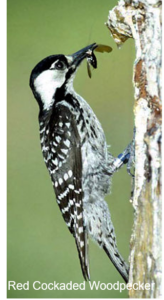EPA Releases Pesticide and Endangered Species Educational Resources Toolbox
go.ncsu.edu/readext?1032684
en Español / em Português
El inglés es el idioma de control de esta página. En la medida en que haya algún conflicto entre la traducción al inglés y la traducción, el inglés prevalece.
Al hacer clic en el enlace de traducción se activa un servicio de traducción gratuito para convertir la página al español. Al igual que con cualquier traducción por Internet, la conversión no es sensible al contexto y puede que no traduzca el texto en su significado original. NC State Extension no garantiza la exactitud del texto traducido. Por favor, tenga en cuenta que algunas aplicaciones y/o servicios pueden no funcionar como se espera cuando se traducen.
Português
Inglês é o idioma de controle desta página. Na medida que haja algum conflito entre o texto original em Inglês e a tradução, o Inglês prevalece.
Ao clicar no link de tradução, um serviço gratuito de tradução será ativado para converter a página para o Português. Como em qualquer tradução pela internet, a conversão não é sensivel ao contexto e pode não ocorrer a tradução para o significado orginal. O serviço de Extensão da Carolina do Norte (NC State Extension) não garante a exatidão do texto traduzido. Por favor, observe que algumas funções ou serviços podem não funcionar como esperado após a tradução.
English
English is the controlling language of this page. To the extent there is any conflict between the English text and the translation, English controls.
Clicking on the translation link activates a free translation service to convert the page to Spanish. As with any Internet translation, the conversion is not context-sensitive and may not translate the text to its original meaning. NC State Extension does not guarantee the accuracy of the translated text. Please note that some applications and/or services may not function as expected when translated.
Collapse ▲ The U.S. Environmental Protection Agency shared the following news release Friday, October 11, 2024, introducing a toolbox of strategies for mitigating the environmental effects of pesticides. The Federal ESA is administered by U.S. Fish & Wildlife Service and the National Marine Fisheries Service, and in North Carolina by the NC Wildlife Resources Commission. You can find a list of Federally endangered North Carolina species at Environmental Conservation Online System (ECOS). To view the Bulletins Live 2 described in the article below, follow this link: Endangered Species Protection Bulletins.
The U.S. Environmental Protection Agency shared the following news release Friday, October 11, 2024, introducing a toolbox of strategies for mitigating the environmental effects of pesticides. The Federal ESA is administered by U.S. Fish & Wildlife Service and the National Marine Fisheries Service, and in North Carolina by the NC Wildlife Resources Commission. You can find a list of Federally endangered North Carolina species at Environmental Conservation Online System (ECOS). To view the Bulletins Live 2 described in the article below, follow this link: Endangered Species Protection Bulletins.
For questions regarding the protection of threatened and endangered species, including the rights and responsibilities of private applicators under the Endangered Species Act, visit the EPA website, Protecting Endangered Species from Pesticides or contact the North Carolina Department of Agriculture and Consumer Services (NCDA&CS) at (984) 236-4575.
Please contact your County Cooperative Extension Center if you have questions or for more information.
EPA Releases Pesticide and Endangered Species Educational Resources Toolbox
Today, the U.S. Environmental Protection Agency (EPA) released an online toolbox with educational materials related to pesticides and endangered species — another step in the agency’s efforts to protect endangered species, support farmers, and provide critical environmental protections for communities across the country.
When EPA registers a pesticide or reevaluates it in registration review, the agency has a responsibility under the Endangered Species Act (ESA) to ensure that the use of the pesticide does not jeopardize the continued existence of federally threatened or endangered (listed) species or adversely modify their designated critical habitats. Over the last few years, EPA has developed strategies and educational materials in support of the agency’s implementation of its ESA obligations. The Pesticide and Endangered Species Educational Resources Toolbox catalogs educational resources including guidance documents, handouts, presentations, informational webinars, and other resources relating to EPA’s endangered species work. The toolbox can be sorted alphabetically, by publication date, or by topic and has a search function that allows users to search by keyword or phrase.
EPA developed the materials in this toolbox for a variety of stakeholders who may have differing levels of knowledge about EPA’s efforts to protect listed species. For example, crop consultants, retailers, extension agents, and others, may use these materials to educate growers and applicators on the ESA strategies or mitigation measures they may see on product labels.
This initial release of the toolbox primarily consolidates existing materials from various locations on EPA’s website into one location. EPA has also included a new one-page handout on Bulletins Live! Two. This handout explains what Bulletins are, why users need to know about Bulletins, and how to find them on Bulletins Live! Two.
EPA will continue adding new materials to the toolbox as they are developed.
VISIT THE TOOLBOX


